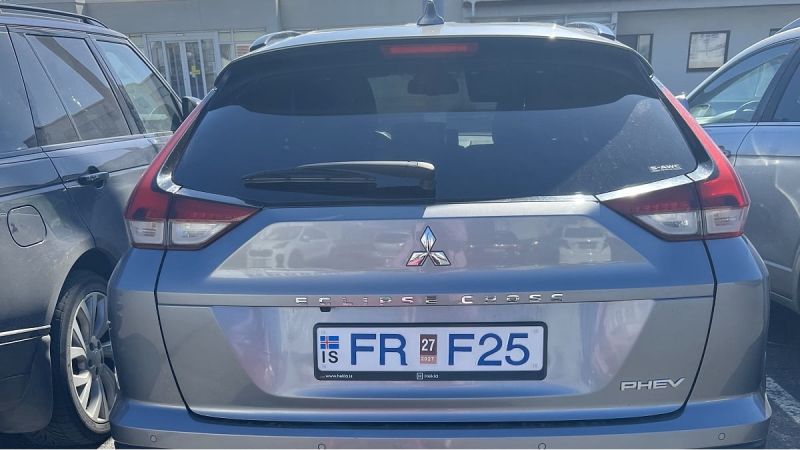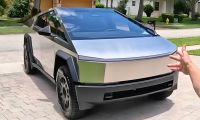Although I am only an occasional vehicle tester here at Torque News, in my household, we drive electric about half of our total miles. My daily driver is a Toyota hybrid-electric vehicle. My husband is a full-time vehicle tester, and about 40% of the vehicles he tests are battery electric, with another quarter being hybrid electric in one form or another. We own and use four EV chargers, including wall-mounted NACS and J-Plug, along with portable NACS and J-plug chargers. Since I had the chance to try a plug-in during my vacation in Iceland, I took it. Here’s why I won't bother with EVs while traveling again in the future.
The Rental - Mitsubishi Eclipse Cross Plug-In Hybrid-Electric Vehicle
When I arrived at the rental counter, I was given the option to swap the default vehicle. Included in my choices was a Mitsubishi Eclipse Cross Plug-In Hybrid Electric Vehicle (PHEV). I figured this would be a great chance to try out a plug-in vehicle, so I took that. We had a Mitsubishi SUV on our last family destination vacation, and it was superb. We’ve also road-tripped on vacation in Outlander PHEVs and had great experiences, so I was glad a Mitsubishi plug-in was available.
Because the car offered had typical controls and infotainment, I had no initial challenges using it upon pickup. We drove around and saw some local sights, using up the EV range, and then went to the hotel to regroup.
Exploring Charging Options
Mitsubishi’s online media page was super easy to navigate. In just a moment, I learned everything I needed to know about the charging options for this Euro-market Japanese-built vehicle. The Eclipse Cross uses two charging methods. The first is what that market refers to as Type 2 (Level 2 in the U.S.). This is widely available, but Level 2 is as slow as molasses. It would take me hours to recharge the car. While fine for overnight home charging, Type 2 is not reasonable while traveling. By my math, I’d only add back about 10 miles or so during a longer-than-usual meal stop. So, Type 2 charging is basically useless. No, my hotel didn’t offer any charging. Nor would I really want to be bothered with waiting for a local Type 2 spot to open up, using it, and then returning to it to move the vehicle again at night after charging was complete.

The Eclipse Cross also offers CHAdeMO DC charging, and that would be quick enough to add meaningful range during a rest or meal stop. It would even be fast enough that it would be worth seeking out a spot just to add some range. I used Google Maps and found that a “gas station” near me had the CHAdeMO DC option available, it was not occupied, and it was just a quick walk back to the hotel. So I figured I’d give it a try.
Apps Apps, and More Apps
I arrived, and the station’s app confirmed my location and the specific CHAdeMO charger cable. I input all of the info in just an instant, even though the app kept reverting to Icelandic. All went well to that point, but despite spending time trying various payment methods, including Mastercard, American Express, a debit card, and Apple Pay, the app still refused to accept any form of payment I could offer it. Unlike some chargers I’ve used with my husband in the U.S., this one had no credit card swiper. This was very frustrating. Eventually, I accepted defeat, and I moved the vehicle 20 feet to a gas pump. The gas pump had a card swiper and took the first card I tried, just like every gas pump on the planet does. I topped it off in seconds.
Here are the apps we carry for use when dealing with public EV charging.
I Didn’t Give Up - I Kept Trying to Charge
There is no shortage of CCS and CHAdeMO DC chargers in Iceland. The island has great infrastructure, and I was able to find a second DC charger that was compatible with the Mitsubishi Eclipse Cross, and I pulled in. A new app would be needed, so I downloaded a second charging station brand app. This one also would not accept any of my many forms of payment, so I was unable to initiate the charge. I tried one last time, had the same result, and I ran out of available time to mess with charging.
I Won’t Bother With An EV On Future Vacations
I’m in a family with members who test battery-electric vehicles, we own multiple hybrid-electric vehicles, and one of us works for a European battery-electric vehicle manufacturer. Who better than me to try out EVs while traveling? Yet, my time was wasted, and I found travel charging to be an endless list of minor hassles. Could I have invested more time and somehow forced it to work? Likely. But why? The vehicle was still a very green hybrid-electric vehicle. Even when its traction battery capacity was below the level required for full-time EV-only operation, it still operated temporarily in EV mode during use. So, what’s the point? I’m glad I gave it a try, but my vacation time is too precious to be bothered with charging hassles. On future vacations, I’ll opt for hybrid-electric or conventional vehicles and skip the need to plug in. Under no circumstances would I want a battery-only vehicle. Luckily, the PHEV powertrain gave me the chance to try charging with no consequences when it didn’t work out. Here’s a quick rundown of some of my travel notes:
- Total distance driven - 600 miles
- Total Time spent inputting gas - 4 minutes.
- Total time spent trying and failing to charge - about 30 minutes.
If you've tried a plug-in vehicle for the first time on vacation, tell us in the comments below how it went for you.
Do you think EV chargers should all have simple swipe payment options rather than forcing you to use a specific app?
Do you think rental EVs help or hurt promote EV adoption?
Images by Hande Tuncer.
Hande Tuncer, MD, is a contributing writer to Torque News and publications related to medical topics. When she is not submitting a guest story or working as a clinician and researcher she enjoys spending time with her family and friends. You can follow Hande on Tiktok at @handehayirlioglut.











